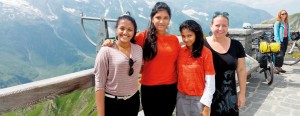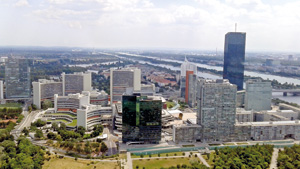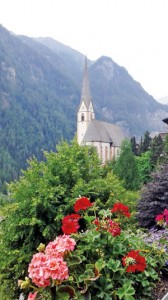Austria:Living every moment
View(s):The winds blow forever around the Donauturm, the 250m tower on the north bank of the Danube River, from which one can survey all of Vienna, Austria. Despite the late hour, I can still spot the luminous silhouettes of the UN’s Headquarters in Vienna, of the Prater amusement park, of the string of bridges that cross the Danube, surrounded by a million sparks of light and life. Three planes circumnavigate a dam on sky, awaiting clearance to land at the airport that lies just over the horizon.

Discovering Austria: Three friends (left to right) Sasini Wickramasuriya, Krishnajina Kuruppu and Shanela Ranaraja with their teacher Sylvia Kren Wanninayake
Three weeks ago, on our first overseas trip alone, my two school friends and I were as ignorant of what lay before us as many of the passengers on those planes. Now I welcome them silently to this landscape as though it were my own. If I could, I would tell them. There is so much in store for you.
It is the height of summer in Austria. The light lasts from half past five to well past nine in the night. Time is elastic, but in Vienna, it is not time which challenges us, three teenagers with weeks of relative freedom unfolding before us. The challenge is choosing wisely when it comes to filling that time.

The modern city: UN HQ Vienna seen from the Donauturm
As far as that choice goes, my companions and I allow ourselves to be enthralled by this gracious and efficient city. Its elegant buildings impress rather than intimidate us, rising gracefully above pristine streets peopled by timeless tramcars that run like perfect wind-up toys and by all the latest Benzes. An iron representation of some great man, usually upon a handsome stallion whose mane is turning green with esteemed age, occupies every second corner. We are fascinated by the Museumsquartier, also the eighth largest cultural area in the world. We hear of one museum devoted entirely to globes, another to papyrus, still another to planned or “artificial” languages – such as the elf languages from the Lord of the Rings.
At a Modernist exhibition of Monet, Picasso, and the like in the famed Albertina museum, Picasso’s “Mediterranean Landscape” bestows upon me a sense of grudging awe and a headache. Later on, we visit the Belvedere – a historic palace and museum as beloved by Vienna as the Dalada Maligawa is revered by Kandy. No other museum boasts so large a collection of works by the Austrian artist, Gustav Klimt.
 In the Austrian Gallery of the Belvedere, I am blinded by a canvas daubed in gold paint and primary colours and geometric shapes. It is Klimt’s “Der Kuss” – “The Kiss”. Short as my visit has been, I have already gathered that Klimt, despite his extravagant tendency to combine gold leaf with oils in his paintings, is unbelievably popular and “The Kiss” is more popular still. And yet it is merely a substitute for the most beloved painting of all – “Adele Bloch-Bauer.” Completed in 1907, the portrait is of a wealthy Jewish patroness of the artist. Following her death and the flight of her family during World War Two, the painting was looted by the Nazis and later appropriated by the Belvedere. There it hung for 60 years before being restored in 2006 to Adele’s niece, who sold the painting to a New York gallery for 73 million pounds. The people of Vienna flocked to the Belvedere, and even organized a poster campaign, to bid a last goodbye to their Adele – whose portrait, whatever the disputes regarding its ownership, has become the Mona Lisa of Austria.
In the Austrian Gallery of the Belvedere, I am blinded by a canvas daubed in gold paint and primary colours and geometric shapes. It is Klimt’s “Der Kuss” – “The Kiss”. Short as my visit has been, I have already gathered that Klimt, despite his extravagant tendency to combine gold leaf with oils in his paintings, is unbelievably popular and “The Kiss” is more popular still. And yet it is merely a substitute for the most beloved painting of all – “Adele Bloch-Bauer.” Completed in 1907, the portrait is of a wealthy Jewish patroness of the artist. Following her death and the flight of her family during World War Two, the painting was looted by the Nazis and later appropriated by the Belvedere. There it hung for 60 years before being restored in 2006 to Adele’s niece, who sold the painting to a New York gallery for 73 million pounds. The people of Vienna flocked to the Belvedere, and even organized a poster campaign, to bid a last goodbye to their Adele – whose portrait, whatever the disputes regarding its ownership, has become the Mona Lisa of Austria.
As fascinating as the tale of Adele is, another woman of Viennese history intrigues me with her omnipresence. Her face looks out of prints on restaurant walls and her silver-gowned form dances through snow globes in shop windows. She smiles enigmatically out of the past on the city which she once held in thrall. Elisabeth Amalie Eugenie, the penultimate Empress of Austria, better known to her people as “Sisi”, was married at 16 to Emperor Franz Joseph I, who took the throne in December 1848. She was an outsider in the elite royal society – but despite her trials or perhaps because of them, she took her life into her own hands. With the Treasury at her disposal, she revelled in beauty, fashion, and travel, and yet she was present at the empire’s crucial moments; she helped cement the Austro-Hungarian union in 1867. As I walk through Vienna, I wonder how it looked through Sisi’s eyes – what she loved, what she sought to escape.
And yet, as my travels take me beyond Vienna, I think I see, like Sisi, how it may be possible to love a landscape, and at the same time, seek to escape it. In Roseldorf, a village in the wine-growing district of Austria, I see geometrical fields of wheat and corn and sunflowers, stretching for miles towards gently sloping hills – and not a living being in between. Not even a crow. A little further on in a town called Pulkau, the bells of St. Michael’s Church toll to their own ancient tune. In the graveyard below, ivy curls slowly over marble headstones, each plot a sunburst of fresh floral arrangements. Outside the smallest town in Austria, Hardegg, I stand on a bridge that divides Austria from the Czech Republic, above a river which once ran red with the desperation of those victims of many wars who were denied passage here. And always, solitude lies over the land like silence, so different from the electric air of Vienna.
In another of these pastel-hued villages, I meet an old man, the proprietor of a family restaurant, who is consumed by the solitude of his hobby. He is a toy collector. He shows us brass toys from the last two centuries in glass fronted cases – entire railway stations, battalions of toy soldiers, kitchens with tiny working stoves, even a miniature Nazi parade, led by a miniature Hitler. To the toy collector, born into the rundown aftermath of two World Wars, the room is a shrine to a child who starved away for want of fun. “I had a lost childhood,” he tells me. “This is why I do this.” Austria, then, was not always the land of plenty that it appears to be now. But its people seem to forget that fact.
A strange machine advances along an early morning street in Salzburg. When I realize that its only excuse for existence is to water the perfectly manicured roadside shrubs, I realize also how thoroughly the average Austrian is cosseted. The idea that trams might ever be thirty seconds late, that dogs might ever exist minus collar, leash and muzzle, that weeds might ever grow beside roads – even roads among the highest of the Central Alps – is inconceivable. Convenience, comfort, beauty are established. Anything slightly akin to a problem is so well-hidden that it is unrecognizable – even the graffiti lining Tube tunnels is a means of decoration rather than objection. And yet it must be a hollow sort of comfort. Like living in a crystal goldfish bowl – forever sheltered, denied the freedom to earn each moment of survival, a freedom which is still familiar to us.
But there are places, even in Austria, where one still realizes how very small one is. In the colossal Museum of Natural History, I navigate a hall dominated by dinosaurs and try not to imagine living in a time when they dominated the world. Indeed, confronting the thousands of butterflies, beetles, and other insects in the Insects’ Hall – a few specimens of the Blue Mormon and the Ceylon Birdwing amongst them – similarly overwhelms me. On the Großglockner High Alpine Road I stare across plunging ravines to Austria’s highest peak, where that mysterious creature, snow, endures forever at more than 12000 feet above sea level and know that the wilderness still lives. And standing at the Giant’s Door of the Stephansdom with over 800 years of history watching me through stained-glass windows, ancient chants reverberating in the slanting light, I know that – despite all the perfection that exists here – we are only finite, wherever we may be.
And so, at ten o’clock in the night, I find myself racing along a tarmac road through endless wheat fields. The sunset is shot through with gold and mauve and green, like a painting by Klimt. It is 14 degrees Celsius; the air is almost solid in our throats. And I think upon what Sisi and the echoes of St. Stephen’s Cathedral and all the lights that dare to cross the Danube, and Austria itself, have taught me – that whether we struggle for survival or we float in golden security, the world demands that we live with everything that is in us, for as long as there is life in us.


